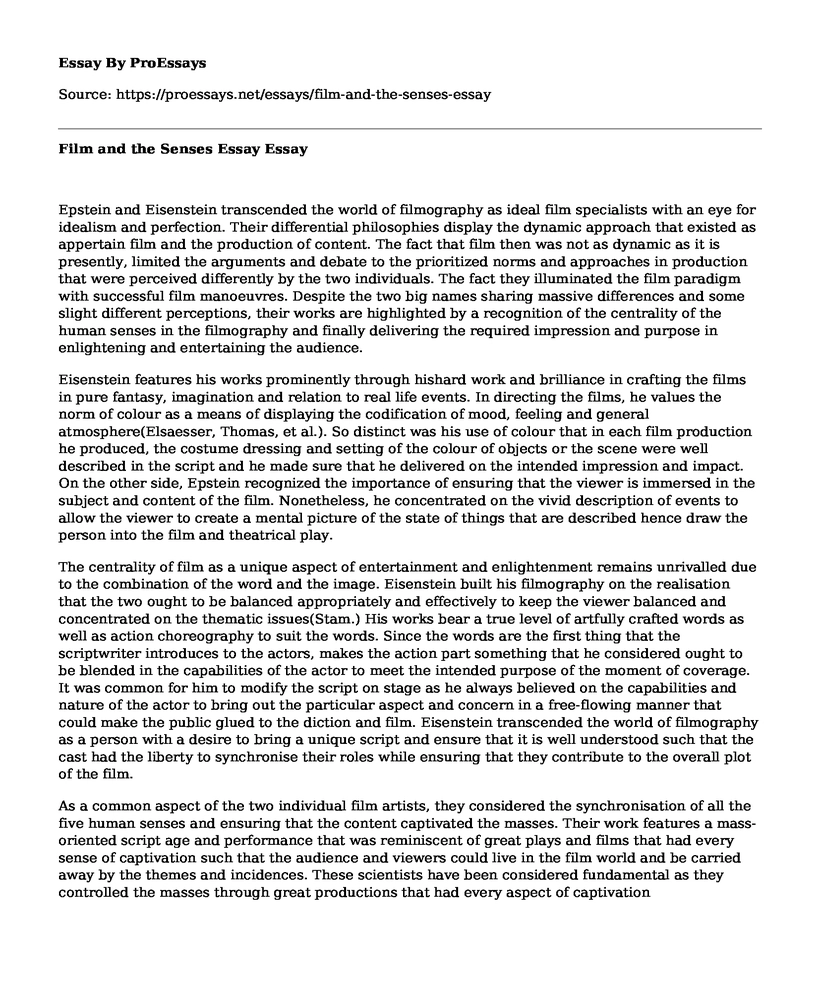Epstein and Eisenstein transcended the world of filmography as ideal film specialists with an eye for idealism and perfection. Their differential philosophies display the dynamic approach that existed as appertain film and the production of content. The fact that film then was not as dynamic as it is presently, limited the arguments and debate to the prioritized norms and approaches in production that were perceived differently by the two individuals. The fact they illuminated the film paradigm with successful film manoeuvres. Despite the two big names sharing massive differences and some slight different perceptions, their works are highlighted by a recognition of the centrality of the human senses in the filmography and finally delivering the required impression and purpose in enlightening and entertaining the audience.
Eisenstein features his works prominently through hishard work and brilliance in crafting the films in pure fantasy, imagination and relation to real life events. In directing the films, he values the norm of colour as a means of displaying the codification of mood, feeling and general atmosphere(Elsaesser, Thomas, et al.). So distinct was his use of colour that in each film production he produced, the costume dressing and setting of the colour of objects or the scene were well described in the script and he made sure that he delivered on the intended impression and impact. On the other side, Epstein recognized the importance of ensuring that the viewer is immersed in the subject and content of the film. Nonetheless, he concentrated on the vivid description of events to allow the viewer to create a mental picture of the state of things that are described hence draw the person into the film and theatrical play.
The centrality of film as a unique aspect of entertainment and enlightenment remains unrivalled due to the combination of the word and the image. Eisenstein built his filmography on the realisation that the two ought to be balanced appropriately and effectively to keep the viewer balanced and concentrated on the thematic issues(Stam.) His works bear a true level of artfully crafted words as well as action choreography to suit the words. Since the words are the first thing that the scriptwriter introduces to the actors, makes the action part something that he considered ought to be blended in the capabilities of the actor to meet the intended purpose of the moment of coverage. It was common for him to modify the script on stage as he always believed on the capabilities and nature of the actor to bring out the particular aspect and concern in a free-flowing manner that could make the public glued to the diction and film. Eisenstein transcended the world of filmography as a person with a desire to bring a unique script and ensure that it is well understood such that the cast had the liberty to synchronise their roles while ensuring that they contribute to the overall plot of the film.
As a common aspect of the two individual film artists, they considered the synchronisation of all the five human senses and ensuring that the content captivated the masses. Their work features a mass-oriented script age and performance that was reminiscent of great plays and films that had every sense of captivation such that the audience and viewers could live in the film world and be carried away by the themes and incidences. These scientists have been considered fundamental as they controlled the masses through great productions that had every aspect of captivation
Works Cited
Elsaesser, Thomas, and Malte Hagener. Film theory: An introduction to the senses. Routledge, 2015.
Stam, Robert. Film theory: an introduction. John Wiley & Sons, 2017.
Eisenstein, Sergei. "Synchronization of Senses." The Film Sense (1968): 60-91.
Epstein, Jean. "On certain characteristics of photogenie." French film theory and criticism: A history/anthology 1929 (1907): 314-18.
Cite this page
Film and the Senses Essay. (2022, May 15). Retrieved from https://proessays.net/essays/film-and-the-senses-essay
If you are the original author of this essay and no longer wish to have it published on the ProEssays website, please click below to request its removal:
- American TV Programs Imaging of Arabs as Terrorists and Villains
- Essay Sample on Surrealist Film: Rejecting Theatrical Psychology & Challenging Art
- Essay Sample on Origins of Operetta: A Look at Musical Theatre
- Paper Example on Overcoming Addiction: Tom & John's Journey
- Essay Example on Sonny's Blues: Music, Race, Suffering, and Hope
- Essay Sample on Aliens on Earth: UFOs in American Newspapers
- Essay on Ennio Morricone's Final Performance: 90-Year-Old Musician Retires in London







